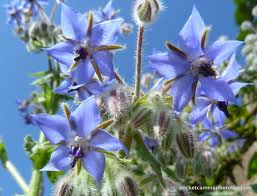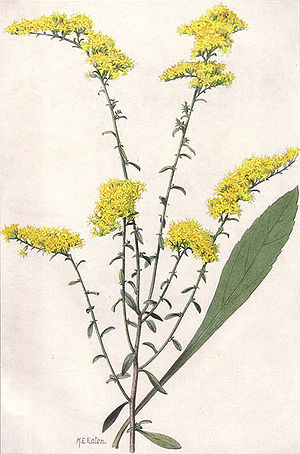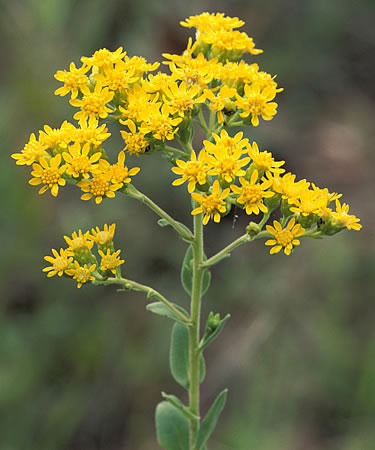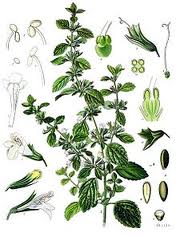Okay, I’ve accepted that all of you aren’t going to become beekeepers, despite my best efforts to persuade you to don a beesuit and pick up a smoker and a hive tool.
Some of you are allergic. Some of you just can’t understand how I can enjoy playing with critters that sometimes sting me. Beekeeping isn’t for everyone, and that’s okay.
So is there anything you can do to help save the bees? Absolutely!
As most of you know, bees collect nectar and pollen from plants for food. They make honey from the nectar. Pollen is their sole protein source (honey bees are vegetarians) and they use it to make food for their young.
Some plants have more nectar and pollen than others. According to Dr. Vetaley Stashenko, an apiculturist, naturopath and apitherapist, the five top plants to support the honeybees with nectar and pollen throughout the season are Borage, Echium (also called Viper’s Bugloss), Goldenrod, Melissa (also called Lemon Balm), and Phacelia (also called Tansy).
They’re not exactly plants you find at your local nursery. I had to search a bit to even find seeds for all of them!
But they are quite lovely, and will blend in nicely with the typical English border.
Borage
Borage is a self-seeding, medicinal annual that can over-winter. Young leaves and blue blossoms may be used in salads. It provides spring forage for honeybees, and blooms into the summer.
Echium
Echium aka Viper’s Bugloss is a spring blooming shrub with repeat bloom. Fall bloom provides nectar for bees for overwintering. The most unusual feature of Echium vulgare is the protection of the nectar inside the flower from vaporization (when it’s hot) or flushing away (when it rains). It is why almost for 2 months this plant is a stable source of nectar for bees. Additionally this plant produces nectar throughout the day unlike most plants which produce nectar for a short period of time. If the bees have a good access to Echium they can collect between 12-20 lbs of nectar a day. The concentration of sugars in the nectar vary 22.6-48.3% depending on the quality of the soil, and not on the amount of rain. The honey is light amber in color and very fragrant with a pleasant taste, and does not crystallize for 9-15 months.
Goldenrod
Goldenrod is a perennial that blooms July through September, and so is important for the timing of a colony preparing for winter. Long bloom period of 25 days; grows anywhere and can be invasive. Honey is dark amber, strong tasting, rich in protein and high in minerals. Medicinal plant that helps with fungus, especially in urinary tract.
Melissa
Melissa aka Lemon Balm is a perennial with a prolonged bloom of 45 – 50 days generally in summer, but with repeat blooming in warmer climates. Delicate honey with very light, pinkish color.
Phacelia
Phacelia aka Tansy is one of the best spring forage sources for honeybees. It’s a perennial that blooms 45-60 days and continuously produces nectar throughout the day. Can be seeded several times per year.
Because the seeds were somewhat difficult to locate, I bought them in bulk. If you would like some, please let me know and I will send you a gram (about 100 seeds) of each of the five for $10.00. That is much cheaper than buying five individual packages.
Related articles
- New English Garden Bee Plants – “Essence Purple” and “Silver Mist” English Lavender (romancingthebee.com)
- Do Bees Like Roses? (romancingthebee.com)
- Why ‘natural’ beekeeping could save our honey-making friends (telegraph.co.uk)
- The Honeybee: A Blessing From Allah (garethbryant.wordpress.com)
- The beekeepers of Somerset (countrylivinged.com)
- Bee Friendly: A planting guide for European honeybees and Australian native pollinators (milkwood.net)












I copied this information for future use. I’m looking for a home to purchase now and it must have great garden space. Will those grow in Oregons very wet climate? If so, I would love to purchase some seeds from you plus shipping of course.
They are wildflowers and will grow anywhere! 🙂
The seeds are small so I’m pretty sure I can send them with a 42 cent stamp. Postage is included. Email me your info and I will send them along. They arrived today. 🙂
ddelong@ddlconsulting.com
I would like some as well !!
I’ve sent you an email.
Jim
Sounds good!!
xo Deb
I would very much like to order those seeds. the name is Tim. Im in Colorado @ three zero three six four seven two four nine six
You previously expressed interest in ordering seeds for the five plants bees like best – Goldenrod, Purple Tansy, Lemon Balm, Borage and Vipers’ Bugloss. http://romancingthebee.com/2013/01/16/the-five-plants-bees-love-best/
Are you still interested? If so, let me know how many packets you want by emailing me at rtbee@me.com or ddelong@ddlconsulting.com. Please include your address!! I will send you the seeds asap and you can send me a check for $10 per pack to:
Deborah DeLong
3326 Columbia Parkway
Cincinnati, Ohio 45226
513-659-8798
Thanks!!
Once you plant Borage, you will always have borage! It self seeds all over and I use the pretty sky blue flowers in salads as they are edible.
That’s a very good point! Do you find that your bees flock to them??
Yes, they are covered with them!
Awesome!! 🙂
xo Deb
Nice to know that I’m already feeding the bees; I grow everything listed except the viper’s bugloss. I do love photographing and filming the bees in my garden – they also seem to love agastache. I hope people take advantage of your kind offer; wonderful plants, all, and deer resistant as well.
I’m glad to know they’re deer resistant too!!
I was just going to say I’m copying this down so I can grow these in our flower bed in Seattle, when I saw your offer to send seeds!! I’d love to buy a $10 packet from you too. I’ll contact you at the email address you provide above. I’m so looking forward to spring planting.
You previously expressed interest in ordering seeds for the five plants bees like best – Goldenrod, Purple Tansy, Lemon Balm, Borage and Vipers’ Bugloss. http://romancingthebee.com/2013/01/16/the-five-plants-bees-love-best/
Are you still interested? If so, let me know how many packets you want by emailing me at rtbee@me.com or ddelong@ddlconsulting.com. Please include your address!! I will send you the seeds asap and you can send me a check for $10 per pack to:
Deborah DeLong
3326 Columbia Parkway
Cincinnati, Ohio 45226
513-659-8798
Thanks!!
I have tansy in my garden – it’s pretty and really tall!
Thanks for the info!! And thanks for growing tansy!!
xo Deb
The first photo is an echium that grew from two feet the year before to 10 feet last year. The bumbles were on it from late May until late August. I’ve also grown comfrey witch is a relative of both echium and borage…(same family with the hairy leaves.)
Comfrey is a medicinal plant that not only blooms for a good 2-3 months here, but camouflaged my blueberry bushes so the birds didn’t get them. Don’t forget the St. John’s Wort (bush type) i’ve gotten six bees on one medium sized blossom. They go gah-gah over it. It blooms from June til August…(Oregon Coast)
The ranchers around here don’t like tansy in their fields. It poisons their cattle. I’m not big on cattle, but I DO like to get along with my neighbors. 🙂
Haha, yes, you don’t want ranchers mad at you!
Thanks for the info about Comfrey and St. John’s Wort!! I’m going to post some more about bee-friendly plants. 🙂
I wish I lived on the Oregon Coast…
xo Deb
Copied this all for future use. I have a literal sandbox for a yard and am not staying here long but oh man do I look forward to having a small place packed with ‘bee food’ soon. Thanks for the great info!
You are very welcome!!
xo Deb
[…] The Five Plants Bees Love Best (romancingthebee.com) […]
[…] The Five Plants Bees Love Best […]
[…] The Five Plants Bees Love Best (romancingthebee.com) […]
[…] The Five Plants Bees Love Best (romancingthebee.com) […]
Great advice. I love to see the honeybees in my garden. Also I love the way you interspersed the botanical drawings through your post–I adore them.
This does inspire one to start a bee friendly garden..in Costa Rica perhaps.. The wonderful thing you also included was the holistic medicinal properties on the Goldenrod and the edibility factor on the Borage. I am always on the lookout for new things to enhance an organic food experience. Savoring your flavor descriptions… Thanks for sharing.
Ta-Ta for now…
[…] The Five Plants Bees Love Best (romancingthebee.com) […]
If you have seeds to spare, I would love some
I will check and see what I have left!!
I am absolutely interested please let me know if you have a 5 pack available as well! What a cool thing you are doing indeed!!!!!!
You previously expressed interest in ordering seeds for the five plants bees like best – Goldenrod, Purple Tansy, Lemon Balm, Borage and Vipers’ Bugloss. http://romancingthebee.com/2013/01/16/the-five-plants-bees-love-best/
Are you still interested? If so, let me know how many packets you want by emailing me at rtbee@me.com or ddelong@ddlconsulting.com. Please include your address!! I will send you the seeds asap and you can send me a check for $10 per pack to:
Deborah DeLong
3326 Columbia Parkway
Cincinnati, Ohio 45226
513-659-8798
Thanks!!
very informative, if you have any of the packets left i would also like to get this. thanks
You previously expressed interest in ordering seeds for the five plants bees like best – Goldenrod, Purple Tansy, Lemon Balm, Borage and Vipers’ Bugloss. http://romancingthebee.com/2013/01/16/the-five-plants-bees-love-best/
Are you still interested? If so, let me know how many packets you want by emailing me at rtbee@me.com or ddelong@ddlconsulting.com. Please include your address!! I will send you the seeds asap and you can send me a check for $10 per pack to:
Deborah DeLong
3326 Columbia Parkway
Cincinnati, Ohio 45226
513-659-8798
Thanks!!
Hello,
Thank You for all the valuable information. I also would be interested in your seed offer.
Thanks
Rob
You previously expressed interest in ordering seeds for the five plants bees like best – Goldenrod, Purple Tansy, Lemon Balm, Borage and Vipers’ Bugloss. http://romancingthebee.com/2013/01/16/the-five-plants-bees-love-best/
Are you still interested? If so, let me know how many packets you want by emailing me at rtbee@me.com or ddelong@ddlconsulting.com. Please include your address!! I will send you the seeds asap and you can send me a check for $10 per pack to:
Deborah DeLong
3326 Columbia Parkway
Cincinnati, Ohio 45226
513-659-8798
Thanks!!
Phacelia is not Tansy…we have both here in Wales: one is yellow, the other purple 🙂
The problem is the picture on my post which I will change asap. We call Phacella “Purple Tansy”. Bees like both, but the purple one a bit better!!!
Thanks for the great catch!! 🙂
I see you wrote this post in January. It’s fall here in Ohio and I am planning my garden since I am hoping to have honeybees this spring (i already bought a beehive!) Do you still have seeds to ship – I saw you mentioned the 100 seeds of each five plants for $10. I would very much be interested.
You previously expressed interest in ordering seeds for the five plants bees like best – Goldenrod, Purple Tansy, Lemon Balm, Borage and Vipers’ Bugloss. http://romancingthebee.com/2013/01/16/the-five-plants-bees-love-best/
Are you still interested? If so, let me know how many packets you want by emailing me at rtbee@me.com or ddelong@ddlconsulting.com. Please include your address!! I will send you the seeds asap and you can send me a check for $10 per pack to:
Deborah DeLong
3326 Columbia Parkway
Cincinnati, Ohio 45226
513-659-8798
Thanks!!
Reblogged this on IslaLove and commented:
In hopes of having honeybees come spring time, I thought I would share this to remind me of top five plants to be used. Also, even if you don’t desire to have bees, you can always help by growing bee-friendly plants!
Do these honeybee plants grow well in the southwest ….southern New Mexico?
You previously expressed interest in ordering seeds for the five plants bees like best – Goldenrod, Purple Tansy, Lemon Balm, Borage and Vipers’ Bugloss. http://romancingthebee.com/2013/01/16/the-five-plants-bees-love-best/
Are you still interested? If so, let me know how many packets you want by emailing me at rtbee@me.com or ddelong@ddlconsulting.com. Please include your address!! I will send you the seeds asap and you can send me a check for $10 per pack to:
Deborah DeLong
3326 Columbia Parkway
Cincinnati, Ohio 45226
513-659-8798
Thanks!!
Can you send the seeds to Australia ,
Regards,
Jasna
You previously expressed interest in ordering seeds for the five plants bees like best – Goldenrod, Purple Tansy, Lemon Balm, Borage and Vipers’ Bugloss. http://romancingthebee.com/2013/01/16/the-five-plants-bees-love-best/
Are you still interested? If so, let me know how many packets you want by emailing me at rtbee@me.com or ddelong@ddlconsulting.com. Please include your address!! I will send you the seeds asap and you can send me a check for $10 per pack to:
Deborah DeLong
3326 Columbia Parkway
Cincinnati, Ohio 45226
513-659-8798
Thanks!!
Paul in Texas says:
I also would like to try those seeds, that is if you still have some. I’m just North of Houston. We have a lot of plants that bee’s like for the honey flows but, none don’t last anywhere near as long, as some that you mentioned do.
I’d be obliged.
Paul
You previously expressed interest in ordering seeds for the five plants bees like best – Goldenrod, Purple Tansy, Lemon Balm, Borage and Vipers’ Bugloss. http://romancingthebee.com/2013/01/16/the-five-plants-bees-love-best/
Are you still interested? If so, let me know how many packets you want by emailing me at rtbee@me.com or ddelong@ddlconsulting.com. Please include your address!! I will send you the seeds asap and you can send me a check for $10 per pack to:
Deborah DeLong
3326 Columbia Parkway
Cincinnati, Ohio 45226
513-659-8798
Thanks!!
Hi! I want some! I’ve just been bitten by the bee bug and must have my own bees. I want to plant all these this year. How do I contact you?
You previously expressed interest in ordering seeds for the five plants bees like best – Goldenrod, Purple Tansy, Lemon Balm, Borage and Vipers’ Bugloss. http://romancingthebee.com/2013/01/16/the-five-plants-bees-love-best/
Are you still interested? If so, let me know how many packets you want by emailing me at rtbee@me.com or ddelong@ddlconsulting.com. Please include your address!! I will send you the seeds asap and you can send me a check for $10 per pack to:
Deborah DeLong
3326 Columbia Parkway
Cincinnati, Ohio 45226
513-659-8798
Thanks!!
I would like to purchase a packet of seeds from all five varieties of plants.
Thanks,
Keith
You previously expressed interest in ordering seeds for the five plants bees like best – Goldenrod, Purple Tansy, Lemon Balm, Borage and Vipers’ Bugloss. http://romancingthebee.com/2013/01/16/the-five-plants-bees-love-best/
Are you still interested? If so, let me know how many packets you want by emailing me at rtbee@me.com or ddelong@ddlconsulting.com. Please include your address!! I will send you the seeds asap and you can send me a check for $10 per pack to:
Deborah DeLong
3326 Columbia Parkway
Cincinnati, Ohio 45226
513-659-8798
Thanks!!
I’d love some of the echium. I only have a 4×4 raised garden but I definitely want something to help the bees. I can’t find your email address to email you.. I’m on my phone though. Maybe it will show up when I check desktop. Will the plants survive zone 6?
You previously expressed interest in ordering seeds for the five plants bees like best – Goldenrod, Purple Tansy, Lemon Balm, Borage and Vipers’ Bugloss. http://romancingthebee.com/2013/01/16/the-five-plants-bees-love-best/
Are you still interested? If so, let me know how many packets you want by emailing me at rtbee@me.com or ddelong@ddlconsulting.com. Please include your address!! I will send you the seeds asap and you can send me a check for $10 per pack to:
Deborah DeLong
3326 Columbia Parkway
Cincinnati, Ohio 45226
513-659-8798
Thanks!!
I would love to grow these flowers and would like to pay the $10.00 for some seeds. How do I go about doing this. Thanks, Chris
You previously expressed interest in ordering seeds for the five plants bees like best – Goldenrod, Purple Tansy, Lemon Balm, Borage and Vipers’ Bugloss. http://romancingthebee.com/2013/01/16/the-five-plants-bees-love-best/
Are you still interested? If so, let me know how many packets you want by emailing me at rtbee@me.com or ddelong@ddlconsulting.com. Please include your address!! I will send you the seeds asap and you can send me a check for $10 per pack to:
Deborah DeLong
3326 Columbia Parkway
Cincinnati, Ohio 45226
513-659-8798
Thanks!!
Do you still have the seeds available for 2014?
You previously expressed interest in ordering seeds for the five plants bees like best – Goldenrod, Purple Tansy, Lemon Balm, Borage and Vipers’ Bugloss. http://romancingthebee.com/2013/01/16/the-five-plants-bees-love-best/
Are you still interested? If so, let me know how many packets you want by emailing me at rtbee@me.com or ddelong@ddlconsulting.com. Please include your address!! I will send you the seeds asap and you can send me a check for $10 per pack to:
Deborah DeLong
3326 Columbia Parkway
Cincinnati, Ohio 45226
513-659-8798
Thanks!!
I would like to purchase some too please.
You previously expressed interest in ordering seeds for the five plants bees like best – Goldenrod, Purple Tansy, Lemon Balm, Borage and Vipers’ Bugloss. http://romancingthebee.com/2013/01/16/the-five-plants-bees-love-best/
Are you still interested? If so, let me know how many packets you want by emailing me at rtbee@me.com or ddelong@ddlconsulting.com. Please include your address!! I will send you the seeds asap and you can send me a check for $10 per pack to:
Deborah DeLong
3326 Columbia Parkway
Cincinnati, Ohio 45226
513-659-8798
Thanks!!
We started our hive last May (2013)…bees seem to be doing well and are already finding pollen sources on these warm days..what a winter. I would love to purchase some seeds too!
You previously expressed interest in ordering seeds for the five plants bees like best – Goldenrod, Purple Tansy, Lemon Balm, Borage and Vipers’ Bugloss. http://romancingthebee.com/2013/01/16/the-five-plants-bees-love-best/
Are you still interested? If so, let me know how many packets you want by emailing me at rtbee@me.com or ddelong@ddlconsulting.com. Please include your address!! I will send you the seeds asap and you can send me a check for $10 per pack to:
Deborah DeLong
3326 Columbia Parkway
Cincinnati, Ohio 45226
513-659-8798
Thanks!!
I would like some of the seeds. How do I order them?
You previously expressed interest in ordering seeds for the five plants bees like best – Goldenrod, Purple Tansy, Lemon Balm, Borage and Vipers’ Bugloss. http://romancingthebee.com/2013/01/16/the-five-plants-bees-love-best/
Are you still interested? If so, let me know how many packets you want by emailing me at rtbee@me.com or ddelong@ddlconsulting.com. Please include your address!! I will send you the seeds asap and you can send me a check for $10 per pack to:
Deborah DeLong
3326 Columbia Parkway
Cincinnati, Ohio 45226
513-659-8798
Thanks!!
Good Day
Do you still have seeds ? Kobus
I’m getting some more soon!
You previously expressed interest in ordering seeds for the five plants bees like best – Goldenrod, Purple Tansy, Lemon Balm, Borage and Vipers’ Bugloss. http://romancingthebee.com/2013/01/16/the-five-plants-bees-love-best/
Are you still interested? If so, let me know how many packets you want by emailing me at rtbee@me.com or ddelong@ddlconsulting.com. Please include your address!! I will send you the seeds asap and you can send me a check for $10 per pack to:
Deborah DeLong
3326 Columbia Parkway
Cincinnati, Ohio 45226
513-659-8798
Thanks!!
I would like some seeds too!
Ok! I’ll let you know when they come in!! 🙂
Reblogged this on Romancing the Bee and commented:
This is a very popular post and many of you have requested seeds this year. I’ve restocked and will be happy to fill any and all orders!!
Reblogged this on hocuspocus13.
How do we go about ordering?
Send me your address via my email and how many you want. I’ll send the seeds and you can send me a check. Sorry to be so low-tech!!
You previously expressed interest in ordering seeds for the five plants bees like best – Goldenrod, Purple Tansy, Lemon Balm, Borage and Vipers’ Bugloss. http://romancingthebee.com/2013/01/16/the-five-plants-bees-love-best/
Are you still interested? If so, let me know how many packets you want by emailing me at rtbee@me.com or ddelong@ddlconsulting.com. Please include your address!! I will send you the seeds asap and you can send me a check for $10 per pack to:
Deborah DeLong
3326 Columbia Parkway
Cincinnati, Ohio 45226
513-659-8798
Thanks!!
When I started reading this post, I was surprised to see tansy listed as one of the top 5 bee herbs since I have loads of tansy (Tanacetum vulgare), but have never once seen a bee on it. Then I saw the photo with the caption Phacelia. Ahhh… It all makes sense. That Phacelia is a beautiful flower!
Reblogged this on An Unexpected Joy.
give me your e mail and I will order seeds from you
pjmcsharry@hotmail.com. and . tony_mcsharry@yahoo.com
My email is ddelong@ddlconsulting.com
You previously expressed interest in ordering seeds for the five plants bees like best – Goldenrod, Purple Tansy, Lemon Balm, Borage and Vipers’ Bugloss. http://romancingthebee.com/2013/01/16/the-five-plants-bees-love-best/
Are you still interested? If so, let me know how many packets you want by emailing me at rtbee@me.com or ddelong@ddlconsulting.com. Please include your address!! I will send you the seeds asap and you can send me a check for $10 per pack to:
Deborah DeLong
3326 Columbia Parkway
Cincinnati, Ohio 45226
513-659-8798
Thanks!!
Reblogged this on Bring Me Bees.
A beautifully detailed post. I am always trying to increase my knowledge of plants beneficial to bees and other pollinating insects and posts like this always help! Personally I have planted Borage and Phacelia this year.
Deborah
Many thanks for starting to follow me at greenbenchramblings. I hope you enjoy your visits. Malc
Just found your blog as I’m making a handout list for things to plant for our pollinators. Nice work. Will add some borage near my hives.
http://www.beehomesoon.com
Hi Deborah, I’ve shared this most informative of blog posts around a bit today, I hope you don’t mind.
Best Wishes and keep fighting for our bees.
Tony
Like Julie, I too find some of these plants do not get as many bees. My Goldenrod is one, maybe because it blooms much later, that or Caryopteris has all the bees buzzing in my yard at that time of year. I do notice the Carpenter bees on the goldenrod most often though.
Hi. My daughters birthday is bee themed and I’m giving pots, soil, magnifying glasses and hopefully seeds as favors. Her party is Oct 4. Any suggestions on a seed we can plant in early October in NC that will help bees?
Thanks!
I would some of those seeds if would please
I raise bees but am having a hard time getting plants or seeds that flower in fall or that feeds bees.
My husband and I watched an interesting documentary about bees. We are interested in planting a bee garden. We live in North Texas and it gets VERY hot in the summer. There are many days when the temp is around 100. Would these plants survive in that kind of heat?